Top News
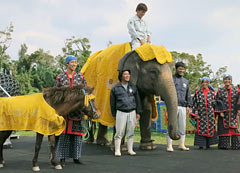
December 5, 2013 Ryukyu Shimpo
For three days from November 29 to December 1, the Chibana Hanaori Business Cooperative held its fourth exhibition at the Okinawa Zoo and Museum Children’s Center in Okinawa City. At the opening ceremony on the 29th, an elephant appeared dressed in a special Chibana hanaori outfit. Those watching enjoyed the unveiling of the extra large garment.
The exhibition showcased about 50 kimono and obi with the woven fabric that the Japanese government has designated as a traditional craft. There were also displays of costumes worn by people and horses in Okinawan traditional horseracing called umaharase. The exhibition attracted many visitors.
The organizers displayed and sold various craft items made of the woven fabric, such as bags, ties, wallets and cardholders. A working loom was displayed and visitors were encouraged to try weaving on it. The chairperson of the cooperative, Mika Hanashiro, said, “We want to treasure our links with people, and would like many people to use Chibana hanaori.”
(English translation by T&CT, Megumi Chibana and Mark Ealey)
Go to Japanese
December 5, 2013 Ryukyu Shimpo
The Okinawa branch of the Federation of Japan Confectionery Associations baked 260 Christmas cakes for welfare institutions in Okinawa on December 4. This was part of annual welfare projects supported by the Okinawa Prefecture Council of Social Welfare and Community.
About 400 confectioners and student members of the association gathered at the Okinawa Flour Milling Service Center in Naha. They decorated sponge cakes with butter cream and chocolate.
The head of the association, Genshun Shimoji, said, “I would like the members of the institutions to enjoy the cakes and some early Christmas good cheer.”
The association presented the cakes to the council on December 5.
(English translation by T&CT, Mark Ealey)
Go to Japanese
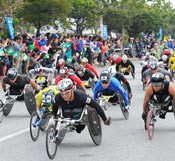
December 9, 2013 Ryukyu Shimpo
The National Federation of Workers and Consumers Insurance Cooperatives Cup 25th Ginowan Wheelchair Marathon started from the Ginowan Seaside Park on December 8.
Fukuoka resident Sho Watanabe won the half marathon for the first time.
There were 249 participants, 44 in the half marathon, 60 in the 3.5 kilometer race and 145 in the 5 kilometer time prediction race. A total of 245 competitors completed the full distance, so almost 100 percent of the contestants finished.
After the start gun sounded at around 10:00 a.m., the contestants moved off together in front of the Kankai Gate.
The participants enjoyed the event at their own pace, with the sky clearing up during the race.
(English translation by T&CT, Mark Ealey)
Go to Japanese
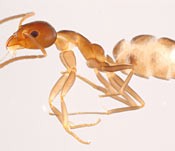
December 4, 2013 Hisao Tome of the Ryukyu Shimpo
The U.S. and Japanese governments plan to move the facilities at Futenma to Henoko in Nago, where they will reclaim land to build a new base. The Japanese government intends to use earth and sand from Yamaguchi Prefecture. On December 3 the Ryukyu Shimpo found that the invasive alien species known as the Argentine ant, inhabits this area. Japanese law forbids the breeding and transporting of these ants.
Ministry of the Environment documents state that the ants have damaged sugarcane overseas.
The Civil Engineering and Construction Division of the Okinawa Prefectural Government (OPG) is checking the application for the reclamation. Concerned that Argentine ants will come in with the earth and sand, on December 4 the division asked the Okinawa Defense Bureau to explain the countermeasures they are planning.
There are no previous cases of Argentine ants being found in Okinawa.
A professor at the University of the Ryukyus and an expert in ants, Kazuki Tsuji, said, “Argentine ants are prolific breeders. Okinawa must not allow these ants in because they would upset the prefecture’s ecosystem.”
As of July 2013, the ministry had found these ants breeding in 20 locations such as Tokyo, Kanagawa Prefecture, Osaka and Kyoto.
The bureau plans to collect rock debris from Mukoshima in Hofu City and Kurokamijima of Shunan City in Yamaguchi Prefecture. The Japanese government has found that the ants breed in Iwakuni, Yanai and Hikari and Ube, which all are close to the areas where the bureau will collect the debris.
The Japanese government has also found that the ants breed in Okayama City, about 25 kilometers northwest of Shodo Island, another area where the bureau will collect debris.
Since 2006, the two prefectures of Hiroshima and Yamaguchi and four cities have set up a Broad-area Counter-Measures Group in an attempt to deal with the Argentine ant. They are cooperating to create a set of guidelines to deal with damage caused by the ants.
The Ministry of the Environment has put together a book about controlling the Argentine ant. It says that the ants damage sprouts and flowers of agricultural goods.
In Hiroshima and Yamaguchi, the ants bit people sleeping and have infested bedding. These prefectures regularly carry out extermination using bait containing an insecticide component.
A spokesperson of the OPG Department of Environmental and Community Affairs said, “This ant is one of the species introduced to Japan that damages the ecosystem, humans and farm goods. If we ever find these ants in Okinawa, all the relevant administrative organizations will need to work hard to deal with the insect.”
A representative of the ministry said, “We need to be really careful about bringing in soil etc. from areas inhabited by an invasive alien species.”
Glossary
Argentine ant
The Ministry of the Environment names the ant as an invasive alien species to Japan. As a general rule, the Invasive Alien Species Act bans the breeding and transporting of these ants. The International Union for Conservation of Nature and Natural Resources has listed the ant among the Top 100 Worst Invasive Species. The ministry found the ants breeding in Hatsukaichi City in Hiroshima Prefecture in 1993, and have confirmed the ants as existing in 20 areas nationwide. It is about 2.5 millimeters long. Competitive, it has been confirmed as sometimes driving out other ants in and outside of Japan.
(English translation by T&CT, Mark Ealey)
Go to Japanese
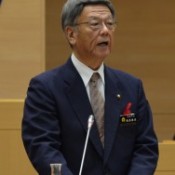
December 6, 2013 Ryukyu shimpo
The Naha City Assembly began questioning the Naha Municipal Government on December 6 as the December round of regular meetings. On the issue of moving the facilities at Futenma to Henoko in Nago, Mayor Takeshi Onaga said, “Even in these difficult circumstances, the fire burning for all Okinawans remains.” He expressed his wish to keep the hearts of Okinawans united in a nonpartisan manner, and for significant developments to happen. Onaga said, “I will persevere with my belief as I have done to date.”
Onaga talked about the importance of pledges made by politicians. He said, “Politics without confidence in its rulers will not stand. Pledges carry much weight.” Onaga continued, “Politicians are responsible for seeking to deliver what they officially promised.” On December 2, the Naha City Assembly unanimously passed a protest resolution against pressure from the Japanese government designed to promote moving the base to Henoko. The mayor praised the resolution, saying, “The assembly members understand the feelings of Naha citizens and the weight of the pledges.”
Onaga said, “The fire burning for all Okinawans remains. I hope that many Naha citizens and Okinawans take up this fire, which will help bring about significant developments.”
(English translation by T&CT, Lima Tokumori and Mark Ealey)
Go to Japanese
December 9, 2013 Ryukyu Shimpo
On December 8, Okinawa Governor Hirokazu Nakaima talked about the plan to move the Futenma base to Henoko in Nago and the Japanese government’s policies to promote the Okinawan economy. He said, “These are completely separate issues.”
Nakaima will decide beyond the end of December whether or not to approve the application documents to reclaim land off Henoko. During that same period, the Japanese government will propose its budget bill for fiscal 2014. It is trying to make Nakaima approve the plan by implying a connection with the budgeting for promotion of the Okinawan economy, but he has nipped that concept in the bud.
Nakaima talked to the press after meeting Minister of State for Okinawa and Northern Territories Affairs Ichita Yamamoto at the governor’s office. He said, “I do not think the plan is linked with the promotion of the Okinawan economy. When Okinawa returned to Japan, the central government started policies to promote economic development in Okinawa to shorten the economic gap between Okinawa and the main islands. There are no strings attached.”
Both the houses of Representatives and Councilors unanimously passed the Act on Special Measures for the Promotion and Development of Okinawa. Referring to this, Nakaima said, “Okinawa’s wishes go no further than what the act provides. I think that the people of Japan understand that.”
(English translation by T&CT, Mark Ealey)
Go to Japanese
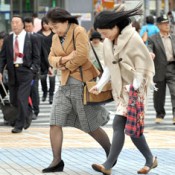
November 29, 2013 Ryukyu Shimpo
On November 28, the islands of Japan experienced a typical winter atmospheric pressure pattern in which high pressure lies to the west and low pressure to the east. This brought cold weather to the Okinawa region. At 8:16 a.m. that day the temperature went down as low as 11.6 C in Oku in Kunigami. This is the lowest recorded this year. According to the Okinawa Meteorological Observatory, cold weather will continue until the morning of November 30.
At 7:57 a.m. in Ashimine in Naha it was 14.4 C, 4.9 degrees below the normal temperature and the lowest recorded in November.
Many people wearing coats and scarves walked quickly to avoid being outside too long at the Shintoshin, Palette Kumoji, and other downtown areas.
(English translation by T&CT, Hitomi Shinzato and Mark Ealey)
Go to Japanese
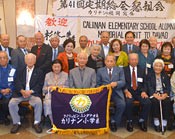
November 29, 2013 Ryukyu Shimpo
The Calinan Elementary School for the children of Japanese immigrants in the Philippines brought an end to 41 years of reunions on November 22. Until it was closed because of the war the school was located in the Davao region of Mindanao in the southern Philippines, where many Okinawan immigrants lived. They decided to disband the organization because the number of participants at each gathering has decreased every year due to the advancing age of the remaining alumni.
Keeping the organization going in recent years has become difficult. Twenty-four former pupils from between the 2nd and 12th intakes took part in the final reunion in Chatan. They reminisced and shared memories of classmates who appear in old photographs. All involved regret the alumni reunion coming to an end.
The cultivation of Manila hemp became popular in the Davao region in the early 1900s, attracting many immigrants from Okinawa to the local plantations. The influx of Japanese immigrant workers led to the opening of the Calinan Elementary School in 1934. When the fighting in the Philippines during the war intensified, the Imperial Japanese Army used the school as a barracks. It was closed down in 1945.
Some former pupils came back to Japan, including Okinawa, during and before WWII, and others were repatriated after the war as prisoners of war.
The alumni reunion started 41 years ago to celebrate a former teacher’s 60th birthday. The largest number of participants to attend a gathering was in excess of 200 people, including some who even came from the main islands of Japan. There have also been visits to Davao.
The chairman of the reunion committee is Chatan resident Masao Shimabukuro, 84, of the 4th intake. He said, “Our school ceased to exist during the war so we don’t have any junior members. Those of us who survived the war came together to show each other that we were all still fit and well. But all good things must come to an end. I have proposed that we stop holding these reunions. We will live in separated from each other, but we will each pursue happiness and good health.”
Toshiko Maehira, 78, Ginowan, “I’ve taken part in these gatherings for about five years. It’s a shame that they have to come to an end. I think I’ve got ten more years in me.”
(English translation by T&CT, Mark Ealey)
Go to Japanese
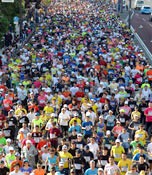
December 2, 2013 Ryukyu Shimpo
The Naha City Government and other organizations held the 29th Naha Marathon on December 1. The participants started in front of Meijibashi intersection on National Route 58 in Naha and ran 42.195 kilometers through the southern part of Okinawa. They finished at Onoyama Athletic Park.
First-time entrant from Shizuoka Shigeaki Hirata won the male-division with a time of 2 hours 27 minutes 56 seconds. Last year’s female-division winner, Tokyo resident Mitsuko Hirose, won again this year.
There were 31,170 applicants for the event, with 27,697 people participating. This was made up of 20,606 men and 7,091 women.
The number of participants who completed the full marathon within the time limit of 6 hours and 15 minutes was 19,298, made up of 15,094 men and 4,204 women. Almost 70 percent of the contestants finished the race, down 2.88 percent from the previous year.
(English translation by T&CT, Mark Ealey)
Go to Japanese
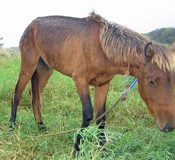
November 23, 2013 Rie Higashihama Correspondent of the Ryukyu Shimpo
A one-and-a-half year-old Yonaguni horse was rescued safely from a freighter stranded on a reef near the northeastern part of Yonaguni Island in the afternoon of November 20. The horse had survived without eating or drinking for 11 days. On its way to Naha from Yonaguni Island, the freighter ran aground on November 10 and remains stuck on the reef. The horse was to be sold and was in transit in a container on the ship.
Although the inside of the container smelled very bad, the temperature was stable with no significant leaning or frequent vibration. Being fit and having been well fed before the ship left Yonaguni allowed the horse to survive.
Veterinarian Shunji Nakamoto who treated the horse said, “When we found the horse, it was thin, but I was relieved to see it stand by itself. I gave it an intravenous drip because it was dehydrated. After that, it went to sleep and woke up by itself. It seems to have an appetite. I’m monitoring its progress.”
The horse did not try to move away from the people who approached it.
(English translation by T&CT, Lima Tokumori and Mark Ealey)
Go to Japanese
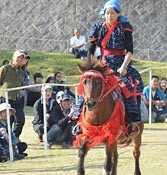
December 2, 2013 Ryukyu Shimpo
Okinawan traditional horse racing, known locally as uma-harashi, was held at the Okinawa Kodomo no Kuni, Zoo & Museum in Okinawa City on December 1. Participants competed on the beauty of their running style and the accuracy of their rhythm. A total of 30 horses, including native Okinawan breeds and others from the West, took part from various parts of the prefecture.
A Yonaguni uma horse called Dunan, which belongs to the Okinawa Kodomo no Kuni, won its third consecutive title.
The horses run parallel to each other using a unique Okinawan style of moving their right front and rear legs at the same time. The jockeys wear clothes made of Chibana hana-ui with characteristic white patterns against an indigo blue background. They also wear traditional Kumejima Island folk articles.
Ryuta Goya, who rode Dunan, said, “I practiced going as fast as I can. I’m happy and relieved to win.”
First-time participant Shinnosuke from Kumejima Island took second place. Keiko Inoue, who rode the horse, said, “I’m a bit surprised. I didn’t expect to come second. I’m glad that he performed so well.”
(English translation by T&CT, Mark Ealey)
Go to Japanese









 Webcam(Kokusai Street)
Webcam(Kokusai Street)


